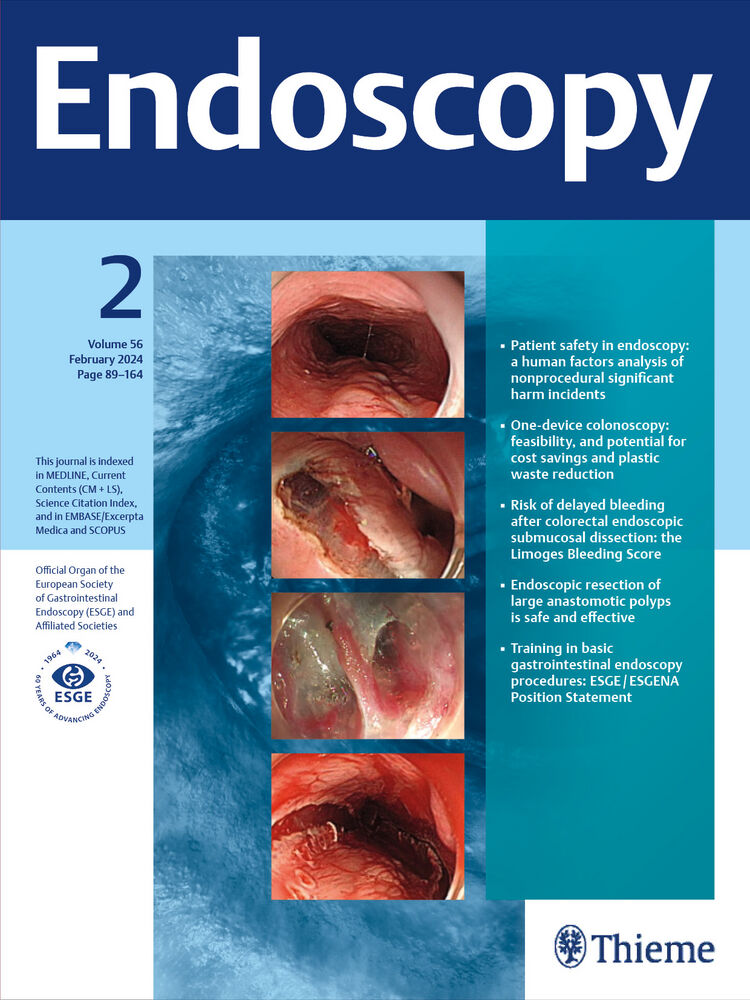Stents for the gastrointestinal tract.
IF 11.5
1区 医学
Q1 GASTROENTEROLOGY & HEPATOLOGY
引用次数: 2
Abstract
mark article, Eckart Frimberger described for the first time the use of an expandable metal stent for esophageal placement [1]. The spiral stent was wound onto a pediatric endoscope so that it was the same diameter as the shaft. After dilation of the stricture to 1–2mm larger than the diameter of the stent (10mm), the stent was passed across the stricture and released in the esophagus where it subsequently expanded to its maximal diameter of 13–15mm. The stent was placed for palliation of malignant dysphagia in 10 patients with adenocarcinoma of the esophagus, and there were no insertion-related adverse events. This report ushered in the era of self-expandable stents for the treatment of luminal strictures. This paper had a profound effect on the practice of endoscopy. The history of stenting goes back to 1885 when Symonds used for the first time a rigid tube to internally stent a malignant stricture [2]. The reader should be aware that this tube was inserted blindly, and it was another three decades before the first report of tube placement over an introducer was published [3]. For a long time, rigid prostheses were made of plastic, polythene or latex. The placement of rigid stents was rather barbaric for both the patient and the physician, as the large diameter of the delivery systems required aggressive dilation. At that time, the use of anesthesia for endoscopic procedures was limited and there was a great deal of procedural and post-procedural pain. We both recall assisting in the placement of rigid prostheses as first year gastroenterology trainees in the early 1990 s. This was done under full anesthesia and it was often a surprise when the patient woke up without major complications. Another landmark article was published a decade later demonstrating the superiority of expandable stents to rigid plastic stents for palliation of malignant dysphagia [4]. Indeed, we both remember placing our first expandable esophageal stent for palliation in the mid-1990 s. The basic principle of the Frimberger stent was embodied in the Esophacoil stent (Medtronic/ Instent, Eden Prairie, Minnesota, USA). This stent had to be withdrawn, however, because the very high expansive force of the stent led to sudden full expansion with severe chest pain and sometimes perforation. Another commercially used stent was the Wallstent (Boston Scientific, Marlborough, Massachusetts, USA), made of stainless steel. The first Wallstents were not covered and this design led to tumor ingrowth. Later, it became possible to partially cover the stent, without leading to a dramatic increase in the insertion delivery system. Other stents in the early era of stent development included the Gianturco Z stent (Cook, Inc., Bloomington, Indiana, USA) and the Ultraflex stent (Boston Scientific), later followed by several other stent designs from different companies. The role of covered stents was shown to be useful for palliation of malignant esophago-respiratory fistulas. The role of expandable stents was eventually broadened (although they continue to remain off-label in most countries) to include the treatment of benign esophageal diseases, such as refractory strictures, leaks, and perforations. Although a variety of stent materials have subsequently been used, such as plastic and biodegradable substances, expandable metal (Nitinol) remains the most common. Following their use in the esophagus, stents have also become available for stricture management in the biliary tract, colon, and gastric outlet (▶Fig. 1). Indeed, modern day esophageal stents are still not dramatically different from those described 36 years ago. Future developments are needed in the area of self-expandable stents, particularly for the esophagus. Migration remains a problem with fully covered metal stents. Focusing on the esophagus, design improvements are needed for placement in the very proximal and the very distal regions of the esophagus. Additionally, stents with larger diameters may be useful for paStents for the gastrointestinal tract胃肠道支架。
本文章由计算机程序翻译,如有差异,请以英文原文为准。
求助全文
约1分钟内获得全文
求助全文
来源期刊

Endoscopy
医学-外科
CiteScore
5.80
自引率
11.80%
发文量
1401
审稿时长
2 months
期刊介绍:
Endoscopy is a leading journal covering the latest technologies and global advancements in gastrointestinal endoscopy. With guidance from an international editorial board, it delivers high-quality content catering to the needs of endoscopists, surgeons, clinicians, and researchers worldwide. Publishing 12 issues each year, Endoscopy offers top-quality review articles, original contributions, prospective studies, surveys of diagnostic and therapeutic advances, and comprehensive coverage of key national and international meetings. Additionally, articles often include supplementary online video content.
 求助内容:
求助内容: 应助结果提醒方式:
应助结果提醒方式:


